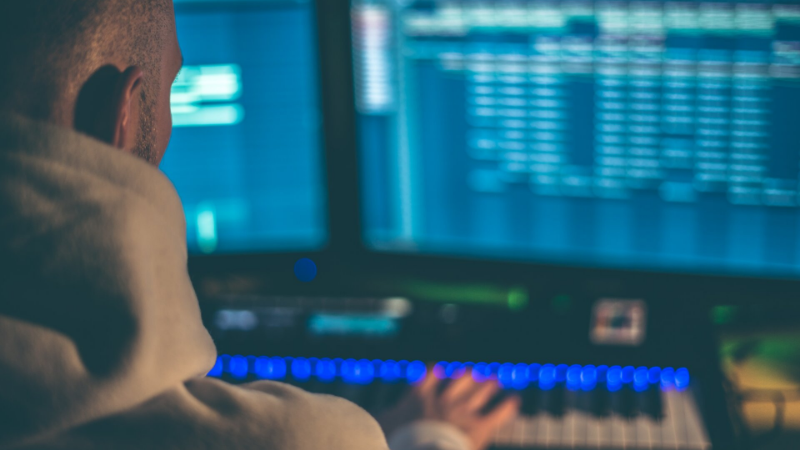
For so many people, writing and producing music is instinctive and intuitive. That can be true even when you’re at the very beginning. The problem is knowing what to do with that. This guide to entry level music production is for you. It should help you make sense of what you need to do next.
How Do I Start Producing Music?
Gather a computer and download a free Digital Audio Workstation of your choice. Interact with the DAW using a mouse, USB piano keyboard controller, or a virtual piano keyboard or drum-pad app on your cellphone. These are used for inputting note information to arrange in the DAW. Add a set of headphones or speakers to complete an entry-level setup. From here familiarize yourself with the DAW. To do so open a new session in the DAW. Open a midi instrument track. Select a virtual instrument. Set tempo, create a loop and start producing.
I know it’s not glamorous, but it is producing at it’s infancy.
Everyone Starts From Zero.
What I just mentioned assumes you have a computer, headphones and something you can use as a controller.
You don’t need to start this rudimentarily but you could.
For now lets expand from this, fill in some blanks, and give you the entry level music production vocabulary and knowledge to get going.
First Thing is First
I mentioned the DAW, that stands for Digital Audio Workstation. A DAW, is a highly sophisticated app that turns your computer into a fully operational studio.
Track (noun)
When the dinosaurs still roamed the earth recording studios were equipped with 24 track tape recorders that could record and playback 24 different channels at the same time. Today all of that recording capability and more can be found inside of your DAW.
Track (verb)
Track means to record. “Today we’re tracking vocals.”
Channel
Remember seeing those big recording consoles. A channel or channel strip is what runs vertically from top to bottom of that console in a column. The console’s size is designated by the number of channels it has.
A channel can be fed by a live source like a microphone or by a recorded track being played back on that channel.
The fader at the bottom would control volume. All of the knobs at the top are for EQing, volume staging or used to send and return track signal to an EFFECT processor, most commonly a reverb or delay. Today all of this is found inside of the DAW.
Editing / Sequencing
After accessibility the things that make the DAW a godsend for an entire generation of musicians and producers are the EDITING AND SEQUENCING features.
MIDI is a digital language used for electronic music sequencing.
I can depress some key on the keyboard and it does not play a note. Instead, it sends some code which represents the key of the note, the pressure of the depression and the amount of time the key was depressed.
I can assign all of that information to any particular sound I have in my sound library, also know as virtual synthesizer.
In the Editing Window we can copy and paste and delete to our hearts content.
If you are familiar with a player piano? It is quite a bit like that. The difference is that on the editing page of a DAW you can manipulate everything on the piano scroll. You can change anything you want at any moment you wish.
AFTER YOU’RE ALL FINISHED and EVERYTHING is TRACKED AND EDITED…
Its Time To Mix-down
This is all done inside the DAW on the giant mixing board that lives inside of your computer.
A Mix-down is when you take all of the tracks that you have recorded and blend those into a stereo two track that you could upload onto Soundcloud or any other platform that you want to use to promote your music.
SUPER COOL…
Right?
What To Do Now
Get your DAW, and get to work. The best place to start is YouTube. You’ll find plenty of entry level music production tutorials there. Those videos will help you to get familiar with your chosen DAW and other production techniques.
It’s important to get a general knowledge of how that particular DAW works before you get to producing. As they say don’t put the cart in front of the horse. If you lay a good foundation you can grow from there. Take the time and ingest the information little by little.
When you feel that you have the general idea of all the different parts of the DAW. Move on to a few follow along tutorials about production on your specific DAW.
After that you will be in position to do what you want to and you’ll have gotten your start producing music.
Getting good at producing music will require repetition and consistency. So keep a long view.
Making Money
You can start making money as soon as someone is willing to pay you. That’s not said to be funny, it’s just a simply stated truth.
Get a schedule, and keep the schedule.
Work until you have produced a prodigious amount of content then keep working.
At some point near the moment when your music has finally become sophisticated and your growing reach has connected to that person out there who hears it and knows exactly what to do with it. That’s when you’ll get paid.
The cold hard fact is that it this takes a certain bit of genius. Either the kind magically divined or the kind developed through tireless effort. There’s no shame in the latter, just respect.
The Differences in Producing Different Genres
To produce is to make the decisions.
In Rock and Roll production the band would have come to the producer with a workable song. That means they’d already have written parts for each musician.
The lyrics and vocal melodies would also be ready to go.
At this point the producers job is to assimilate a clear vision for that song.
Enhance The Song
To be more precise, their job is to enhance the aural experience of hearing that song.
The producer will make adjustments to the arrangement and articulate the usage of the various instruments and effects to enrich the aural experience of the recording.
The Producer will also help vocal melody and harmony revisions. This is also an important role of an EDM, Hip-Hop or Pop Producer.
The Producers ultimate job is working towards the ultimate expression of that song.
Deciding whether it should be intentionally subdued or purposefully grandiose is the work of the producer in accordance with the band.
Provide Guidance
The band passes that burden of guidance to the producer. In my experience as an artist having someone on to produce was rewarding. It challenged you to think past yourself and your own level.
The Producer does all of that work so repetitively that their skill in this area is a specialty skill. You would stand to learn a lot in a situation like that.
The other genres that do not typically require live band production, such as Hip Hop and EDM see the producer as more of a songwriter.
In pop music, the producer has a lot of responsibilities. They build out all of the instrumentation for the song that was licensed from the songwriter for the artist to sing.
Compose Elements
If the song calls for synchronized electronics then perhaps that producer will synchronize the music themselves or hire individual musicians and coach them towards the vision of the song.
In a lot of instances pop producers are known to be songwriters or are in partnership with lyricists and can be contracted by management or label to create a custom song for an artist.
For someone producing beats, whether that is hip-hop or EDM, the roll of duties are somewhat different then those of a rock and roll producer.
Someone interested in being producers in these genres are really more composers. Essentially they are the entire band.
In The End
Work to produce what you know is good and you will be producing good music. After you have produced your music you can promote it on YouTube. We have a great guide to increasing views on YouTube for independent artists. If you need that as a resource you will find it here. Bookmark and Save!
With consistent effort and persistence, anyone can hone their music production skills, evolving into both a skilled producer and an independent artist. The key lies in dedicated practice and a commitment to continuous learning.
Embrace the learning curve of entry level music production , absorb knowledge gradually, and apply it consistently. Over time, your understanding of production nuances will deepen, and your creative prowess will flourish.
Remember, to stay patient, and keep refining skill.
Now go and get to it!
Good Luck
